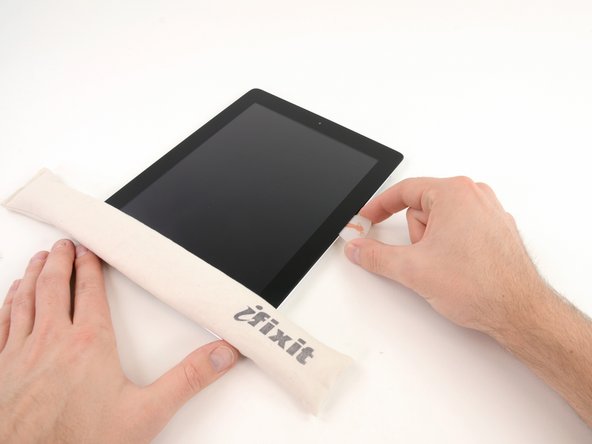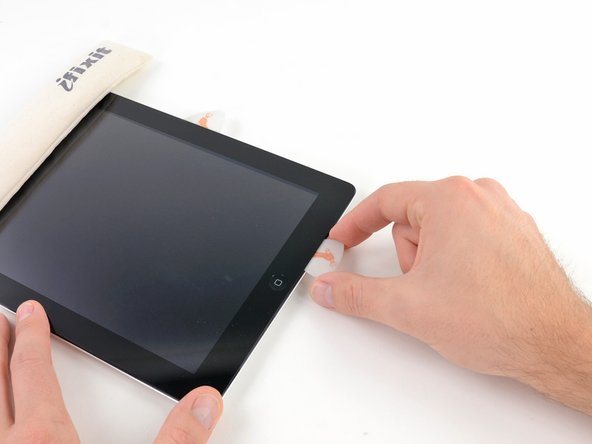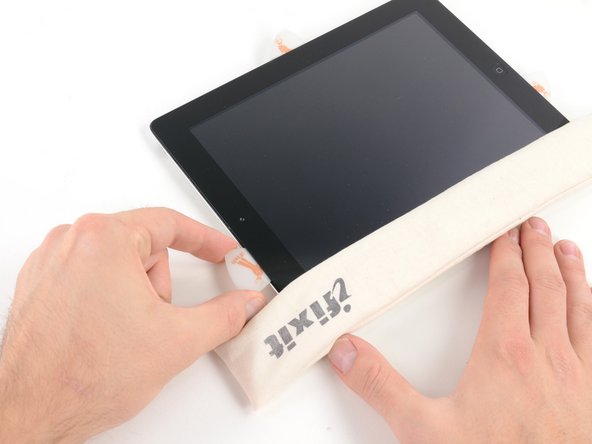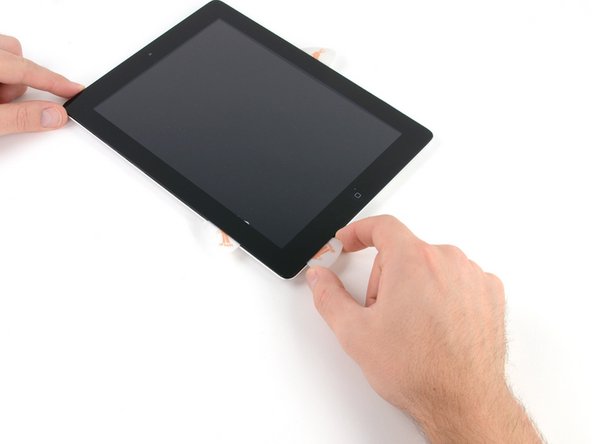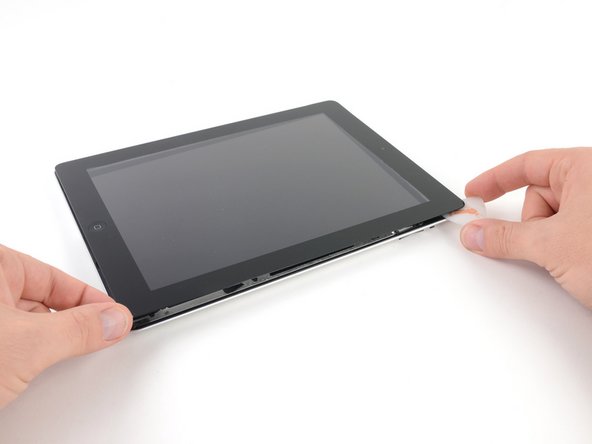iPad 2 GSM LCD Replacement
Duration: 45 minutes
Steps: 36 Steps
Follow this guide to swap out a cracked LCD. Some parts were filmed using a Wi-Fi model, so the inside might look a bit different than the cellular version. Don’t worry—the steps are the same for both, except where we point out the differences.
Step 1
For carousel microwaves: Ensure the plate spins without any hiccups. If your iOpener gets stuck, it might overheat and cause some damage. Keep it moving smoothly!
Before you get started, give your microwave a quick once-over and wipe out any gross leftovers—otherwise, that gunk might hitch a ride on your iOpener and nobody wants that!
- Pop that iOpener right in the center of the microwave like it owns the place!
Tools Used
Step 2
Don't let the iOpener get too hot—seriously, it could pop! Keep it under 100˚C (212˚F) to be safe.
If the iOpener looks like it's swelling, don't touch it. That's a big no-no.
If the middle of the iOpener is still too hot to handle, just chill for a bit. Let it cool down before you heat it up again. A perfectly heated iOpener should stay warm for up to 10 minutes.
Microwave power varies, so your heating time might need a little tweak. The iOpener is ready to roll when it’s just a bit too hot to handle comfortably.
- Pop the iOpener in the microwave for about 30 seconds to get it nice and toasty.
- If it starts cooling down while you work, just heat it up again in 30-second bursts to keep things warm and ready.
Tools Used
Step 3
Heads up! The iOpener gets super hot, so handle with care. If you’re worried, grab an oven mitt to keep those fingers safe.
- Carefully take the iOpener out of the microwave by grabbing one of the two flat ends—avoid the hot middle like it’s the last slice of pizza!
Tools Used
Step 4
The iOpener gets super hot, so make sure to grab it by the end tabs only. Safety first, friend!
No microwave? No problem! Just warm up your iOpener by dipping it in some boiling water instead.
- Grab a pot or pan and fill it up with enough water to give your iOpener a nice, cozy bath.
- Turn up the heat and let that water come to a rolling boil. Once it's bubbling, go ahead and turn off the heat!
- Carefully drop your iOpener into the hot water for about 2-3 minutes. Make sure it’s fully submerged and getting all the love it deserves.
- Using tongs (safety first!), lift the heated iOpener out of the water.
- Give your iOpener a good drying with a towel—let's keep it nice and tidy.
- And voilà! Your iOpener is all set and ready to rock! If it needs a little more warmth, just repeat the process: boil the water, turn off the heat, and let it chill in the water for another 2-3 minutes.
Tools Used
Step 5
Pop on some safety glasses to keep those peepers safe, and handle the LCD screen with care to avoid any oops moments.
This will help keep those pesky glass shards in check while also making sure your display has the strength it needs when you're prying and lifting it up. Stay safe and steady!
- If your display glass is cracked, keep it from shattering more and avoid any ouch moments by taping over the glass before you start.
- Cover the iPad’s screen with overlapping strips of clear packing tape until the entire front is sealed up.
- Follow the rest of the steps as best you can. Just a heads up: once the glass is cracked, it might keep cracking as you work, so you may need to carefully pry out the glass pieces with a metal tool.
Step 6
Just a friendly reminder: you'll be working with some glass that might be a bit cranky during this process. So, throw on those safety glasses to keep your peepers safe from any flying bits!
- Place the iOpener flat against the right edge of your iPad, making sure it makes good contact with the surface. We want it to feel cozy and warm!
- Give it about 90 seconds to work its magic before you dive in to open the front panel.
Tools Used
Step 7
Getting the tip of your opening tool wedged between the glass and plastic might take a little muscle. Be patient and gentle—wiggle that tool back and forth carefully to make some progress without causing damage.
- Look closely at your iPad; there's a sneaky little gap in the adhesive ring at the upper right corner, about 2.0 inches (~5 cm) from the top. Time to take advantage of this tiny flaw!
- Now, let’s get that tool in action! Position it near the mute button, and gently slide the tip of a plastic opening tool into the gap between the front glass and the plastic bezel. Just the tip—enough to create a little wiggle room!
Step 8
- Position the tool carefully between the plastic display bezel and the front panel glass. A little precision goes a long way here!
Step 9
- With the plastic opening tool snugly positioned between the front glass and the plastic bezel, gently slide a plastic opening pick into that little gap right beside the tool. You've got this!
Step 10
- Gently take out the plastic opening tool from the iPad and slide the opening pick underneath the front glass, pushing it in about half an inch. You've got this!
Step 11
- As you gently work on loosening the adhesive on the right side of your iPad, don't forget to give your iOpener a little reheat love and place it back on the bottom edge of the iPad. You're doing great!
Tools Used
Step 12
The adhesive holds on tight, so you might need to put in a little muscle here. Take it slow and steady, and be careful not to overdo it!
If you spot the tip of the opening pick peeking out from under the front glass, gently pull it back just a bit. Using the pick this deep won’t cause damage, but it might leave some adhesive smudges on the LCD.
- While the bottom edge gets cozy with the heat from the iOpener, start peeling off the adhesive from the right side of your iPad.
- Slide the opening pick down the side of the iPad, gently loosening the adhesive as you go.
Tools Used
Step 13
You might need to slide the heated iOpener back over to the right edge of the iPad as you work through releasing the adhesive. How long the iPad’s had to cool off while you’re working will decide if this move is necessary.
- If the opening pick gets stuck in the adhesive, gently 'roll' the pick along the side of the iPad. Keep at it, and the adhesive will start to let go, making your task that much easier.
Tools Used
Step 14
- Before you take out that first opening pick from the bottom corner of your iPad, slide a second pick under the right edge of the front glass to keep the sticky stuff from sticking back together.
- Give your iOpener another quick heat-up, and then position it at the top edge of the iPad.
Tools Used
Step 15
The Wi-Fi antenna is nestled snugly at the bottom right edge of the rear case of your iPad, held in place with screws and a cable. Given its unique position, it's super important to take your time and handle it carefully to avoid any permanent hiccups with the Wi-Fi antenna.
- Alright, this next part requires some serious care. You’re about to free the antenna from the front panel—just make sure to keep everything intact. It’s like a delicate dance, so take it slow.
- Now, gently release the adhesive holding the antenna to the front panel, but don't rush it. We’re aiming to avoid any mishaps with the fragile components that connect the antenna to the iPad's bottom. Follow the next steps with a steady hand, and you'll be fine!
Step 16
Careful now! Don’t slide the pick past the bottom right corner, or you might give the Wi-Fi antenna an accidental workout it won’t appreciate.
- Gently slide the opening pick around the bottom right corner of the iPad, carefully lifting away the adhesive as you go. Nice and steady, you’ve got this!
Step 17
As you glide that opening pick along the bottom right edge of the front panel, keep an eye out! The Wi-Fi antenna is hanging out near the corner, and if the adhesive gets a little too wild, it could get severed. So, let’s be gentle and precise here!
Just a friendly tip: don't yank that pick all the way out from under the front glass! Instead, gently pull it out just enough so that about 1/8" (3 mm) of the tip stays snugly under there. You're doing great!
- Gently slide the tip of your opening pick along the bottom edge of the iPad to carefully loosen the adhesive around the Wi-Fi antenna.
Step 18
- Once you've made it past the Wi-Fi antenna (it's about 3" or 75 mm from the right edge, right next to the home button), go ahead and reinsert the opening pick all the way in.
- Now, gently slide that pick to the right. This will help you break the adhesive that's keeping the Wi-Fi antenna stuck to the front glass.
- The antenna is actually attached to the bottom of the iPad with screws and a cable. This step ensures the antenna is free from the front panel, so when you remove the panel, the antenna stays safe and sound.
Step 19
Keep the iOpener heating sessions under a minute, and remember to chill it out for at least two minutes before firing it up again.
If the adhesive has cooled down too much along the bottom edge, just pop the iOpener back in the microwave for a quick reheat. This will help get the adhesive warm again right where you need it.
- Gently peel away the adhesive along the bottom of the iPad. Once the opening pick is far enough to make it around the home button, pull it out a bit more, then carefully reinsert it, going about 1/2 inch (10 mm) deep beyond the button. Keep it steady and take your time, you've got this!
Tools Used
Step 20
For iPad 4 models, slide the pick in carefully up to about 1/2 inch (10 mm) right here to keep the home button ribbon cable safe and sound.
- Keep sliding that adhesive separator all along the bottom edge of your iPad—almost like peeling off a stubborn sticker.
- Keep the opening pick tucked under the front glass near the home button to hold your progress steady.
Step 21
- Warm up the iOpener in the microwave, then place it on the left edge of the iPad to gently soften the adhesive in that area.
Tools Used
Step 22
If the adhesive has cooled down too much, just replace the iOpener along the top edge and keep going. If it's really cooled off, give it another heat-up and you're good to continue.
- Gently slide that trusty opening pick along the top edge of your iPad, giving it a little tug to navigate around the front-facing camera bracket.
- This section's adhesive is like super glue on a mission, so you might need to channel your inner strength. Take it slow and steady—no need to rush or risk a mishap with your iPad!
- If your opening pick feels like it's stuck in a sticky situation, try giving it a little roll, just like we showed you in step 9.
Tools Used
Step 23
If the adhesive feels nice and warm, go ahead and take the iOpener off the iPad to make things easier. But if it’s still holding on tight, just heat up the iOpener again and keep it on the left edge while you work your magic.
- Keep peeling away the adhesive at the top edge of your iPad, and gently work that opening pick around the top left corner like a pro!
Tools Used
Step 24
The digitizer cable sits about 2" (50 mm) up from the bottom of your iPad. When sliding your pick, pause once you hit roughly 2.25" (60 mm) to avoid any surprises.
- Gently slide your opening pick along the left edge of the iPad to loosen the adhesive bit by bit. Heads up—the adhesive here is pretty thin because of the digitizer running along the entire left side. Keep your pick shallow, no deeper than about 10 mm (half an inch), to avoid poking the digitizer and causing trouble.
Step 25
Be super careful! The bottom of the digitizer cable is just about an inch (25 mm) away from the bottom of the iPad. Take your time and work slowly to avoid cutting this cable. You've got this!
- With the opening pick still tucked under the bottom edge of your iPad, gently slide it to loosen the adhesive at the bottom left corner. Keep it smooth and steady!
Step 26
Sometimes, the adhesive along the edge of the iPad may have decided to stick back down. If that’s the case, just grab a pick and gently slide it under the area where the front glass is still holding on, then carefully ‘cut’ through the adhesive.
- Grab one of those handy opening picks and give the bottom right corner of the iPad a gentle pry. Once it's popped up a bit, use your fingers to grip it with confidence!
Step 27
Watch out for any sticky stuff still hanging around! Grab an opening pick and gently slice through any adhesive that might be keeping the front panel snug. You've got this!
- Grab the iPad by the top and bottom right corners and gently swivel the front glass away from the device.
- When putting it back together, give the LCD a good wipe with a microfiber cloth and a blast of compressed air to clear off any dust or fingerprints before snapping the glass back in place.
Step 28
- Unscrew those four 2.0 mm Phillips screws holding the LCD in place against the rear case. You've got this!
Step 29
- Gently pry the LCD from the edge closest to the volume buttons, then rotate it out of the rear case with a smooth motion.
- Carefully lay the LCD down on the front panel, just like you see in the second picture.
Step 30
- Grab a plastic opening tool and gently lift up the metal clip holding the display data cable in place on the logic board. Take your time, it’s like giving the cable a little wiggle room to breathe.
Step 31
Careful! Don’t yank the display data cable connector straight up when you unplug it—it’s more delicate than it looks.
- Gently pull the display data cable out of its socket on the logic board. Just a little tug and it should come loose!
Step 32
- Gently detach the LCD assembly from your iPad 2 and give yourself a pat on the back for tackling this step!
Step 33
- Peel away the tiny black tape that’s guarding the display data cable connector on the LCD. You're almost there!
Step 34
- Grab a plastic opening tool and gently nudge the metal retaining clip on the display data cable connector to pop it up. You're doing great!
Step 35
Be gentle with that display data cable – no tugging upwards when disconnecting it!
- Gently unplug the display data cable from its socket and carefully lift it away from the LCD.
Step 36
- The LCD is still in place.
- When putting the LCD back into a different device, swap out the foam around it. This foam acts like a little buffer between the digitizer and the LCD, helping to keep those pesky ghost touches at bay.
























